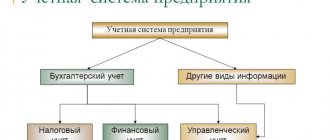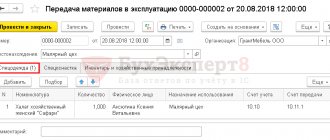Stages of the liquidation procedure
To get an answer to the question “Should the liquidation balance be zero or not?”
Let's look at several points related to the liquidation procedure of an enterprise. In Art. 61–64 of the Civil Code of the Russian Federation highlight the stages that a company must go through during liquidation:
- Making a decision by the management body or the sole owner to close the enterprise.
- Informing the tax inspectorate about the decision made to change data in the Unified State Register of Legal Entities.
- Approval of the special liquidation commission.
- Public communication about the cessation of activities, for example, through the media, on Internet resources.
- Carrying out an inventory of property and liabilities, taking measures to collect receivables and notifying creditors of the liquidation of a legal entity.
- Drawing up an interim liquidation balance sheet.
- Final settlement with creditors.
- Drawing up the final (final) liquidation balance sheet
- Distribution of the property of a legal entity remaining after satisfying the claims of creditors to its founders (participants).
- State registration of the results of company closure.
So, during the liquidation process, several liquidation balance sheets can be drawn up: interim and final. However, they should not be the same.
Read more about the liquidation procedure in the article “Procedure for closing an LLC - step-by-step instructions.”
What documents are required to liquidate an LLC?
To close an LLC, you should prepare documents in advance. Below is a complete list of documents for the entire period of LLC liquidation. This list is complete; separate documents are required for each stage of liquidation. We'll talk about the stages in more detail in the next paragraph of the article.
- Minutes of the general meeting of participants or the decision of the sole founder;
- Notice on Form P15001, notarized;
- Notification of creditors about the closure of the LLC (more details on this in paragraph 4 of this article);
- Notifying employees of dismissal due to the termination of the LLC’s activities and notifying the employment center;
- Reporting to the Pension Fund (form RSV-1);
- FSS reporting (form 4-FSS);
- Reports 2-NDFL and 6-NDFL;
- Interim liquidation balance sheet;
- Notification in form P15001 (this notification is submitted twice: at the beginning and at the end of the liquidation procedure);
- Protocol (decision) on approval of the interim liquidation balance sheet;
- Documents confirming the publication of the closure of the LLC in Vestnik;
- Application in form P16001;
- Final liquidation balance sheet;
- Protocol for approval of the final liquidation balance sheet;
- Receipt for payment of state duty (800 rubles);
- Certificates from the Pension Fund of the Russian Federation and the Social Insurance Fund confirming the absence of debts (it is not necessary to submit these certificates, since the tax authority can independently request information).
Here is a fairly small list of documents you will need at all stages of closing an LLC.
Let's now take a closer look at these stages.
Interim liquidation balance sheet
An interim liquidation balance sheet is drawn up by the liquidation commission only after the deadline for submitting claims by creditors (Clause 1, Article 63 of the Civil Code of the Russian Federation).
The interim liquidation balance sheet must contain information:
- about the property of the liquidated organization (based on inventory results);
- a list of claims presented by creditors and the results of their consideration;
- a list of demands satisfied by a court decision that has entered into legal force, regardless of whether such demands were accepted by the liquidation commission.
Data on property must be confirmed by inventory materials (clause 27 of the PBU on accounting and accounting, approved by order of the Ministry of Finance of the Russian Federation dated July 29, 1998 No. 34n). As a rule, the list of claims presented by creditors and the results of their consideration by the liquidation commission are given in the appendix to the balance sheet; the received document is numbered, stitched and sealed on the back. Thus, based on the requirements for the interim liquidation balance sheet, it can be argued that it cannot be zero.
The interim liquidation balance sheet is approved by the founders (participants) of the legal entity or the body that made the decision on liquidation. In some cases, the interim liquidation balance sheet is approved in agreement with the authorized government body. This procedure is provided for in paragraph 2 of Art. 63 Civil Code of the Russian Federation. Please note that you should not approve an interim liquidation balance sheet if at least one of the following circumstances occurs:
- the court accepted the creditor's claim against the liquidated company for proceedings, and the decision in this case (another judicial act completing the proceedings) has not yet entered into legal force;
- An on-site tax audit is being carried out in relation to the liquidated company, and the final document on it has not yet entered into force.
The law does not directly prohibit the approval of an interim liquidation balance sheet in each of such cases. However, if there is at least one of them, it is impossible to submit a notification to the tax authority about the preparation of an interim liquidation balance sheet (subparagraphs “b”, “c”, paragraph 4, article 20 of the law “On State Registration...” dated 08.08.2001 No. 129-FZ ).
Despite the fact that Law No. 129-FZ does not directly indicate the obligation to submit the interim liquidation balance sheet to the registration authority, it is necessary to submit it, since without an interim balance sheet it will be impossible to verify the reliability of the liquidation balance sheet. And the reliability of the liquidation balance sheet is a necessary condition for registering the liquidation of an organization.
Is it possible by one decision of an LLC participant to approve both the interim and liquidation balance sheets and submit all documents to the Federal Tax Service at the same time? ConsultantPlus experts provided detailed explanations. Get trial access to the system and review the recommendations for free.
Liquidation of an LLC: step-by-step instructions
The process of liquidating an LLC is a rather complicated procedure. Most often, it is entrusted to specialized companies, but it is quite expensive. Even if you are planning to seek help from lawyers, you should familiarize yourself with the main sections of this process. In this section I have tried to explain each step in detail. So…
Step 1 — Preparation for the start of LLC liquidation
At this stage, I advise you to conduct a full analysis of the activities of your organization, so that in the process you do not incur an on-site tax audit and make sure that there are no arrears on certain payments.
If you do not conduct a preliminary analysis, problems may arise and you will have to overpay fines and penalties, and the process of liquidating the LLC will be greatly delayed. Liquidating an LLC can be compared to planning to open a business. There must be a clear algorithm of actions.
I also advise you to decide in advance on the choice of the optimal type of liquidation and settle issues with the co-founders, if any.
Step 2 - Making a decision to terminate the company’s activities and creating a liquidation commission
The decision to terminate the activities of the LLC is made at the general meeting of founders and is confirmed by the minutes of this meeting. Also at the meeting, a liquidation commission is created, which can consist of either one liquidator or other qualified employees (chief accountant, lawyer, director, etc.). This commission has the right to fully deal with the issue of liquidation, represent the interests of the company in court and other authorized bodies (Article 62 of the Civil Code of the Russian Federation). The list of members of the liquidation commission is included in the minutes of the meeting of founders on liquidation; it must include all the passport details of the members and their signatures.
If the company has one founder, then a decision of the sole founder is drawn up.
The liquidation commission does not always consist of employees and founders of the company. If you engage a third-party organization to carry out this process, then the protocol includes information about those people who will liquidate the LLC.
Step 3 - Submitting notices of LLC liquidation to the tax service and funds
Within 3 working days after the decision is made, an application in form P15001, certified by a notary, and the minutes of the meeting of participants or the decision of the sole founder are submitted to the tax service at the place of accounting.
It is important to note that it is not necessary to submit notifications to the funds, the tax office does this on its own, but in our country anything can happen, and when submitting documents to the Federal Tax Service, I advise you to clarify this point, just in case.
Within 5 days after submitting the application and protocol, the tax office makes a change to the Unified State Register of Legal Entities to begin the process of terminating the activities of the LLC, and will also give you a copy of the sheet confirming the changes to the state register.
Step 4 - Publication in the media
You do not have the right to close an LLC while having debts to creditors and counterparties, therefore the liquidation commission is obliged to publish a message about the planned termination of the LLC’s activities in a specialized journal - “Bulletin of State Registration”. This message can be published by filling out the form on the official website.
Step 5 - Notifying creditors of LLC liquidation
In addition to the message in the Bulletin, it is necessary to notify creditors in writing about the planned closure of the LLC; it is important to include in the notification the deadlines for filing claims, etc. (usually, this is two months from the date of filing the application with the tax office). It is important to keep supporting documents about the distribution of these letters. These may be postal notifications, a stamp of the incoming number on your copy of the letter with the date of receipt and the signature of the recipient.
I would also like to note that it is worth remembering not only about creditors, but also about debtors. At the time of closing the LLC, you should not have any receivables. Do this work with your counterparties in advance, send them notifications, put maximum emphasis on this, since after the termination of your activities, you will no longer be able to demand anything from them.
Step 6 - Notifying employees of dismissal and the employment center of termination of activities
At least 2 months before the dismissal of employees due to the termination of the LLC's activities, you are required to send written notices. After dismissal, you will be required to pay severance pay in the amount of one average monthly salary, and employees also retain the right to receive wages until the date of new employment, but no more than 2 months.
You are also required to submit a notification to the employment service. This notification is submitted two months before complete liquidation, sometimes three, but it all depends on the specifics of the region. I advise you to immediately send a notification to the employment center when submitting a notification to the tax office.
Step 7 — Submitting reports for employees
After the process of dismissing employees is completed, you need to submit reports to the Pension Fund (form RSV-1) and the Social Insurance Fund (form 4-FSS). This reporting must be submitted before application P16001.
It is important to remember to check the “Cessation of activities” checkboxes on the title pages of reports to the Pension Fund and the Social Insurance Fund.
Step 8 — Preparing for an on-site tax audit
This step does not always take place, but it is worth knowing and remembering. It is very difficult to say what determines whether an audit will be carried out or not. Most often, “zero” organizations are not checked, but it is still worth preparing in advance. Check if all the documents are in order and correspond to the parameters and data that you and your chief accountant indicated in the reports.
Step 9 — Preparation and submission of an interim liquidation balance sheet to the Federal Tax Service
After the two-month period specified in the Bulletin has expired and issues with creditors have been settled, the interim liquidation balance sheet is submitted. There is no specific form for it, but based on judicial practice, it should be prepared according to the same principles as financial statements. In this matter, I advise you to contact specialists.
The interim liquidation balance sheet must necessarily include the following items:
- information about the property of the LLC;
- information on claims made by creditors;
- results of consideration of the above requirements.
After drawing up, this document must be approved by a decision (minutes) of the meeting of founders or the sole founder.
Next, you provide the following documents to the Federal Tax Service:
- Application in form P15001, certified by a notary (don’t forget to check the box in section 2.3);
- Interim liquidation balance sheet;
- The decision (minutes of the meeting) on the adoption of the interim liquidation balance sheet.
They may also require a document confirming publication in the Bulletin.
After submitting the above documents, the Federal Tax Service is obliged to provide you with a copy of the sheet on amendments to the Unified State Register of Legal Entities within 5 working days.
If at this stage you no longer plan to carry out taxable transactions in the organization, then I advise you to submit a tax return along with the interim liquidation balance sheet. The reporting year for a closing LLC is the year from January 1 of the current year until the date of making an entry in the Unified State Register of Legal Entities on liquidation.
If these transactions are unavoidable, then the tax return is submitted along with the final liquidation balance sheet.
Step 10 - Pay off existing debts
After the interim liquidation balance sheet has been approved by the Federal Tax Service, settlements should begin on the LLC’s debts.
According to Article 64 of the Civil Code of the Russian Federation, debts must be paid in the following order:
- citizens to whom the LLC is liable for causing moral damage or harm to life and health;
- employees under an employment contract (salary and severance pay) and payment of royalties;
- calculations for mandatory payments to the budget and extra-budgetary funds (taxes, insurance premiums, fines, etc.;
- remaining debts to other creditors.
At this stage, the problem of lack of funds may arise, then there are several ways.
The first option is to put the LLC’s property up for public auction. If these funds are not enough, then you should apply to the arbitration court to declare the LLC bankrupt.
If, even at the stage of planning the liquidation of the LLC, you understand that the company does not have enough funds to pay creditors, think about bankruptcy of the LLC in advance and contact a lawyer. You shouldn’t get involved in this venture on your own, as there are a lot of subtleties. LLC bankruptcy is a very complex topic that requires the involvement of competent lawyers.
Step 11 - Preparation and submission of the final liquidation balance sheet, distribution of assets between participants
Once all debts to employees, the state and creditors have been repaid, you should begin preparing the final liquidation balance sheet, which will indicate information about the remaining assets.
It is important to understand that if the final liquidation balance sheet contains more assets than the interim balance sheet, the tax authorities may become interested in this matter and even refuse to liquidate your LLC. This is done in order to identify unscrupulous organizations that withdraw assets at the stage of submitting an interim balance sheet in order to hide information from creditors.
After drawing up the final balance sheet, as in the case of the interim balance sheet, it must be adopted at a meeting of the founders. The decision made is recorded in the form of minutes (decision) of the meeting of founders.
Step 12 — Submission of the final package of documents to the Federal Tax Service
Now you have reached the finish line and must prepare the following package of documents for final submission:
- Application in form P16001;
- Final liquidation balance sheet;
- Protocol on the adoption of the final liquidation balance sheet;
- Receipt for payment of state duty in the amount of 800 rubles;
- Certificates from funds confirming the absence of debts (this item is optional, since the tax office itself requests this information, but it is better to check with the territorial Federal Tax Service whether they are needed or not).
Within 5 working days, the process of liquidation of the LLC will take place, the corresponding entries will be made in the Unified State Register of Legal Entities and the tax office will issue you a copy of the sheet on making changes to the Unified State Register of Legal Entities.
I also recommend that you watch this short video that talks about LLC liquidation in 2021:
The liquidation balance must be zero or not
After all settlements with creditors have been completed, a liquidation balance sheet is drawn up, which must also be approved by the founders (participants) of the legal entity or the body that made the decision to liquidate the legal entity (clause 6 of Article 63 of the Civil Code of the Russian Federation). And here again the question arises: “Should the liquidation balance be zero or not?” The answer to this question is ambiguous. The fact is that at the moment there is no unified methodological approach, enshrined in the legal acts, to the procedure for compiling indicators of the final liquidation balance sheet. In addition, Art. 63 of the Civil Code of the Russian Federation does not establish the priority of drawing up a liquidation balance sheet before the distribution of property between owners. It only states that both of these actions must occur after the creditor has been repaid. It also makes it difficult to answer the question “Should the liquidation balance be zero or not?” the fact that the issue of the competence of the liquidation commission to independently make a decision on the distribution of property remaining after settlement with creditors among the participants (founders) is not regulated by law.
In principle, both positions are valid: that it should be zero, and that it can have indicators (except for the creditor).
Thus, if we assume that the liquidation commission is authorized to distribute the property remaining after settlement with creditors between shareholders and the liquidation balance sheet can be drawn up after the distribution of property, then the answer to the question “Should the liquidation balance sheet be zero or not?” positive.
If we assume that the decision on the distribution of property remaining after settlement with creditors is made by shareholders, and the liquidation balance sheet must contain information about such property, then the answer to the question “Should the liquidation balance sheet be zero or not?” negative.
Due to the uncertainty of the legislation on this issue, it seems that both of the stated positions may be valid, although each of them has its disadvantages.
To learn how property can be divided between participants, read the material “How is property distributed during the liquidation of an LLC?”
The asset total of the final liquidation balance sheet is equal to
Contents In modern business conditions, very often entrepreneurs have to close their projects. Liquidation of a company or production can be caused by various factors. This is both bankruptcy and a simple reluctance to continue doing business. One way or another, the fact remains a fact.
Liquidation of an enterprise is a rather complex process. There is a certain order that should be followed. It is strictly described in the relevant government acts.
So, one of the points is drawing up the liquidation balance sheet of the company.
When an organization is liquidated, its management is obliged to create a liquidation commission, which will deal with the affairs of the enterprise in the future. Including drawing up a liquidation balance sheet. The liquidation balance sheet is a document that describes all the assets of an organization at the time of its liquidation. This balance sheet describes all the company's accounts and tangible assets, as well as accounts receivable and payable.
Consequences of drawing up zero and non-zero balances
The disadvantage of the first position may be the presence of receivables among the assets of the liquidated organization, the collection of which may take quite a long time, and accordingly, the preparation of the liquidation balance sheet will be postponed for an indefinite period (until all receivables are repaid). The second disadvantage of this position is the uncertainty in the procedure for resolving a possible dispute between the participants regarding which of them should receive the remaining property. According to paragraph 8 of Art. 63 of the Civil Code, in the event of a dispute regarding which of the participants needs to transfer an item, the liquidation commission must sell this item at auction, but it seems that certain difficulties may arise with this issue, because this item, by decision of the liquidation commission, has already been transferred to one of the participants. Obviously, in this case, a zero liquidation balance can be approved only after the dispute between the participants is resolved.
The disadvantage of the second position may be the presence among the assets of the liquidated organization of property subject to transport tax and (or) property tax. In this case, the liquidated organization continues to remain a payer of these taxes, and before the distribution or sale of this property, it continues to form accounts payable for these taxes. And, therefore, in this case the liquidation balance sheet cannot be approved, since there will be tax payables.
Can it be zero?
Quite often, companies form a zero liquidation balance sheet, since after the sale of assets and repayment of debts, the company simply does not have any assets left that could be distributed among all participants in the enterprise.
The law does not contain precise information about whether such a balance is always zero, since the availability of property after debts are repaid is determined only by the number of different obligations the organization has.
It is quite easy to draw up a zero balance, so the accountant does not have any difficulties with this work. There is also no need to decide exactly how the remaining property will be distributed among the founders.
In this case, the final liquidation balance cannot be negative. This is due to the fact that under such conditions the debt remains to other creditors. In such a situation, the tax inspectorate cannot enter information about the liquidation of the company into the register, so the bankruptcy process will have to begin.
Liquidation balance sheet: sample filling
The liquidation balance sheet does not have a specially approved form. It is filled out on the form adopted by order of the Ministry of Finance of the Russian Federation dated July 2, 2010 No. 66. Its name must be indicated: interim liquidation balance sheet or liquidation balance sheet. Such recommendations were given in the letter of the Federal Tax Service of Russia dated 08/07/2012 No. SA-4-7/13101.
On our website you can download the balance sheet form “Filling out Form 1 of the balance sheet (sample)” .
The liquidation balance sheet is prepared according to the same rules as the regular quarterly and annual balance sheets.
For information on how to fill out a balance sheet, read the article “Procedure for drawing up a balance sheet (example)” .
There are no special rules for drawing up an interim liquidation balance sheet (you can download a sample of filling out a zero balance sheet during liquidation on our website).
Protocol on approval of the liquidation balance sheet
To approve this document, it is necessary to convene an extraordinary meeting of the company's participants. The protocol is drawn up according to a standard scheme and has the following sections:
- Information about the organization – name, location, TIN;
- Information about the event: date and place of the meeting, opening and closing times, form of holding;
- A list of persons present (or organizations that sent their representatives) indicating the number of votes of each of them;
- Agenda. It should contain several questions:
- selection of meeting bodies (chairman and secretary);
- approval of the liquidation balance sheet;
- sending an application to the tax service to complete the liquidation procedure.
- The progress of the meeting is reflected below. Each issue is discussed and put to a vote. The number of votes “for” and “against” is recorded in the protocol;
- At the end of the protocol, the signatures, positions, surnames and initials of the chairman and secretary are placed.
Latest financial statements
And a few more words about the financial statements of a liquidated legal entity. Features of financial statements during liquidation are given in Art. 17 of the Law “On Accounting” dated December 6, 2011 No. 402-FZ. The reporting year of the liquidated company is incomplete. It begins, as usual, on January 1, but ends on the date preceding the date of entry into the Unified State Register of Legal Entities about its liquidation. On the date preceding the date of entry into the Unified State Register of Legal Entities of an entry on the liquidation of a legal entity, the latest financial statements are drawn up. It must be compiled on the basis of the approved liquidation balance sheet and data on the facts of economic life that occurred in the period from the date of approval of the liquidation balance sheet to the date of entry into the Unified State Register of Legal Entities on the liquidation of the company. Thus, the latest financial statements are a successor not to the previous financial statements, but to the liquidation balance sheet.
In sub. 9 clause 3 art. 21 of Law No. 402-FZ states that the composition of the latest financial statements, the procedure for their preparation and the monetary measurement of objects in them should establish federal standards. But today such standards have not been approved and the procedure for submitting such reports to any government bodies has not been established.
If you decide to liquidate a joint stock company, use the step-by-step instructions from ConsultantPlus. Get trial access to the system and upgrade to the Ready Solution for free.
Results
The liquidation balance sheet can be interim and final. The intermediate version must reflect information about the obligations, property and capital of the organization, and also contain a list of claims presented by creditors, the results of their consideration and a list of claims satisfied by a court decision that has entered into legal force, regardless of whether such claims were accepted by the liquidation commission. The interim liquidation balance cannot be zero.
The final liquidation balance sheet is drawn up after the completion of settlements with creditors and in it the item “Accounts Payable” should be equal to zero. There is no clear answer to the question “the liquidation balance should be zero or not.” The liquidation balance sheet does not have a specially approved form and is filled out on the form of a regular balance sheet.
Sources:
- Civil Code of the Russian Federation
- Order of the Ministry of Finance of Russia dated July 29, 1998 N 34n
- Federal Law of 08.08.2001 N 129-FZ “On state registration of legal entities and individual entrepreneurs”
- Order of the Ministry of Finance of Russia dated July 2, 2010 N 66n
- Federal Law of December 6, 2011 N 402-FZ “On Accounting”
You can find more complete information on the topic in ConsultantPlus. Free trial access to the system for 2 days.
The procedure for liquidating organizations
According to Art. 61 of the Civil Code of the Russian Federation, the closure of a company is carried out with the cessation of its functioning without transfer of rights of use and ownership to third parties. Closing a company can be voluntary or forced.
How to properly reorganize a company:
The decision to liquidate on a voluntary basis is made by the founders, who must be part of the liquidation commission. The process of forced closure of a company is initiated by creditors or supervisory authorities and occurs through the courts.
The decision to liquidate the organization
There are several reasons why a business may close:
- bankruptcy;
- business mergers or restructuring;
- closure of an organization by a voluntary decision of the owner;
- termination of existing activities;
- conducting activities that do not correspond to the direction of the enterprise.
Closing a company is a complex and lengthy process. Drawing up a liquidation balance sheet will be one of its main stages
What does the algorithm for closing a company look like?
- Assessment of the company's property status.
- Cost accounting.
- Compilation of a register of creditors' claims and consideration of claims.
- Interim liquidation balance sheet.
- Sale of existing assets.
- Accounting for expenses of bankruptcy proceedings.
- Satisfaction of creditors' demands.
- Preparation of liquidation balance sheet.
- Liquidation of the enterprise.
The first step towards liquidating an organization will be a meeting of shareholders and founders, at which they will decide to close it. The decision made is recorded in the protocol. If the company has debtors, then it is necessary to develop a mechanism for repaying debts and determine the timing of settlement of obligations.
The second step should be the appointment of a liquidation commission. The rights to manage the organization will be transferred to her. The commission is obliged to warn creditors about the date of closure of the company.
Next, a package of documents is submitted to the tax service:
- decision to appoint a liquidation commission;
- completed form P15001.
The last document must be certified by a notary. To do this, the specialist will require the following documents:
- extract from the registration register;
- articles of association;
- TIN and OGRN certificates;
- protocol on the appointment of the head of the company.
Sample of filling out form P15001
The form is filled out according to the same rules that apply for preparing tax reports. Namely: it is customary to fill out the form typewritten, in capital letters; dashes should not be made in empty columns.
This form P15001 is a document confirming the liquidation of the enterprise
It is necessary to inform interested parties about the closure of the enterprise: for this you should advertise in the newspaper.
If the LLC does not have a debt obligation, the tax service will coordinate the timing of inspections with government agencies. Based on the results of fulfillment of obligations, an interim LP is formed between the company and creditors.
Read all the details about the LLC reorganization in this article:








